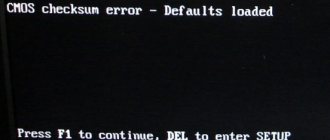Windows operating systems
25.03.201911499
Even an experienced user who knows how to update Explorer and where to look at the operating system settings will at some point encounter a new problem: Windows’ stubborn reluctance to boot. It's not about activation; and, fortunately, reinstallation is not always necessary - most often restoration saves the day. Let's try to figure out how to return Windows 7 to its original state and get rid of accumulated errors.
System utility
Contrary to popular belief, in order to restore Windows 7, one of the most flexible operating systems from Microsoft, it is not at all necessary to restart your computer or laptop, insert the installation disk and switch to Recovery mode. Most often, to resolve startup issues, reverse changes, or disable unsuccessfully selected options, just a few clicks are enough.
All actions described in this section are provided by the manufacturer and do not in any way affect the validity of the license or the health of the computer. Using them to restore Windows 7 is no more difficult than updating Adobe Flash Player - you just need to carefully follow the algorithm.
Important: if the operating system does not start and the user cannot get to the “Desktop”, this method should be skipped and immediately proceed to the next ones.
You can start Windows recovery using the system utility as follows:
- Turn on your computer or laptop and wait for it to fully boot. If for some reason it is not possible to log in as usual, you should try “Safe Mode” by selecting the corresponding item on the start screen by pressing the Enter key. If there are no problems, a “Normal Windows Boot” will be enough to restore the system.
- Left-click on the Windows flag in the lower left corner of the screen, then go to the “Computer” section, the link to which is located in the right panel of the “Start” menu. If desired, the user can create a shortcut on the desktop - then using System Restore, like many other functions of Windows 7, will become much easier.
- In the list that opens, select “System Properties” by clicking the mouse; By using one of the adjacent buttons, you can configure the camera on your laptop or remove unnecessary programs - one of them could lead to crashes in Windows 7.
- Go to the “Advanced system settings” section, located in the left side menu of the new window.
- Switch to the “System Protection” tab, the second one in the list of settings that opens.
- This is where the system recovery management tools are located. By clicking on the button of the same name, the user can begin the operation.
- Windows 7 will offer to restore the most successful, in the OS's opinion, previous settings. If there are no objections, you should click on the “Next” button and follow the prompts of the utility.
- If the user wants to return Windows to another point, you need to set the circle opposite the bottom line “Select another recovery point.”
- The list that opens in the next window will contain Windows 7 restore points created both by the system automatically and by the user himself manually. Having selected the one you need by left-clicking the mouse, click on the “Next” button again. The owner of a computer or laptop can see which applications will be affected by the changes by clicking on the “Search for affected programs” button. This must be done for each point separately.
- Review the operation parameters and click the “Finish” button. If there is no longer a need to restore or you need to select another point, you should use the “O” buttons accordingly.
- Confirm your intentions by clicking on the “Yes” button in the dialog box. As the OS honestly warns, the operation is irreversible: you can flip the screen on a laptop with Windows 7 at any time and in any direction, but you won’t be able to return to the moment “before recovery”.
- Wait until Windows prepares the data to start the process.
- During the recovery process, the user will be switched to the welcome screen - it will begin to display information about the progress of the process.
- As a result, Windows 7 will inform you that the operation is complete and will reboot.
- After turning on the computer or laptop in normal mode, the user will see a message on the screen indicating a successful recovery. Now most of the OS errors should be eliminated; if this is not the case, you should move on to one of the following methods.
- Before starting everyday activities and enjoying the return of Windows to working order, it makes sense to create a “fresh” restore point. This can be done on the already known “System Protection” tab by clicking on the “Create” button.
- Now you need to specify the name of the new “original” version; The more informative it is, the better - it's worth spending a little time on the name instead of using a few random numbers or letters.
- After a minute or two, the system will notify you that the operation has been successfully completed. Now the user can restore Windows 7 to its current state at any time or subsequently prepare several more successful options.
Important: quite often problems with the system are associated with the unsatisfactory condition of the hard drive. To check its functionality, you should call the “Properties” option in the context menu, go to the “Service” tab and select the “Run check” item.
By checking both checkboxes, clicking on the “Start” button and waiting from several minutes to an hour, the user will receive comprehensive information about the health of the disk; in some cases, this will require restarting Windows 7.
System recovery Windows 8/8.1
If you were able to start the OS, you can resume Windows 8 through Settings. Hover over the top right corner and enter them. Click on “Change computer settings” – “Update and recovery”. The “Recovery” section will offer several options:
- "Normal recovery with preservation of information."
- "Deleting data and reinstalling the OS."
- "Special option."
Decide what exactly needs to be done. Next, follow the menu prompts.
If you choose the latter method, in the window that opens, click on the diagnostics item. You will be offered the following options:
- "Restore";
- “Return to original state”;
- "Extra options". This item includes the ability to roll back to the desired resume point.
To resume Windows 8.1, press Win+R and call sysdm.cpl. In the system properties window, in the “Protection” tab, specify the required system drive. Click "Restore". By clicking "Next", you can see a list of rollback points. Select the one you want and click “Search for affected programs.” Changes that have been made to the PC since the selected moment will be deleted. Complete the process by clicking "Finish".
If you work with Windows 8, problems may occur, the Internet may not work correctly, etc. To fix this, you can use the classic recovery method through restore points.
Another option is a system rollback. To do this, open the “Start” menu - “Control Panel” - “Windows Update”. Select the item “Remove updates”. The same can be done using the command line.
So, in the list of updates that opens, we delete those from the moment of installation of which (we look by date) problems and malfunctions began. We delete unnecessary files and reboot.
You can perform a factory reset on Windows 8.1. Important files will not be affected during this operation. The method is effective, but to implement it, the OS needs to boot without problems. We use the algorithm:
- The right side of the monitor is “Settings”;
- "Change settings";
- “Update and recovery” - “Recovery”;
- "Recovery without deleting files."
If you cannot log into the system in the usual way, you must use the disk with the system. Load the installation disk and select “System Restore”. Click the “Diagnostics” button and “Restore”.
Before loading Windows
The Microsoft operating system can behave in different ways: from time to time it produces minor errors, randomly closes running applications, refuses actions that are familiar to the user, or even “crashes” and stops starting in normal mode.
In the latter case, before reinstalling Windows 7, the user can try to restore the system from the boot menu. This can be done by entering “Safe Mode” (or using the installation disk: you don’t need to reinstall anything, you just need to insert it into the drive, restart your computer or laptop and press any key until the OS loads from the hard drive).
After waiting for the black start screen to appear, the user must:
- Go to the Windows Memory Diagnostic section by pressing the Tab key or another - in accordance with the system instructions.
- Select to launch the utility using the Enter key.
- Wait for the memory check to finish - depending on the parameters of the computer or laptop and the severity of the problem, it can take up to one and a half to two hours.
- By clicking on F1, the user can select one of the verification methods: basic, standard or advanced. It is easy to guess that the time spent on the operation increases in proportion to the increase in the included options; however, it is recommended to select a “full” scan once - if the problem with the performance of Windows 7 is related not to the software, but to the hardware component, the user will be able to find out about this before the machine completely fails and take appropriate action.
- If everything is fine with the memory, the computer owner can reboot the device and wait for Windows to start from the hard drive; As a rule, as a result of all manipulations, the operating system will offer to choose one of the start options: “Safe Mode” already known to the user, as well as launching the last successful configuration and standard startup. If until the last moment there were no problems with the performance of the OS, it is worth trying the second method.
- And if the screen appears after the failures have been corrected, for example as a result of an unplanned disconnection of the computer from the network, then “Normal boot”.
- Having selected “Safe Mode”, the user must wait a little while the system loads the necessary configuration; It will do this within two to five minutes, depending on the device parameters.
- In this mode, there is no Internet connection and most services are blocked, so uninstalling an unnecessary program or calling System Restore is much easier.
- Upon completion of work, the user can simply restart the computer or laptop from the Start menu - after turning on, he will see the standard welcome screen.
An additional option to secure your OS
In addition to the method discussed above, you can create a so-called “Recovery Disk” . It will store all the necessary tools for diagnosing and troubleshooting failures when starting Windows and will allow you to easily roll back to previous points with backups, which means you can avoid a complete reinstallation of the OS.
- Go to “Backup computer data”;
- In the next window, select “Create a system repair disk”;
- All you have to do is insert the DVD into the drive and press the “Create” button;
- After completing the copying procedure, you can remove the optical media.
How to use a burned disc if problems occur?
- Insert the optical media into the drive;
- Enter BIOS and set the disk drive to first place in boot priorities;
- Save the changes, then reboot and wait for the graphical interface we need to open.
Another important note
When using any version of the "seven", do not forget to regularly check with an antivirus. Pay attention to the various warnings in your antivirus utility. If the program supports automatic scanning, check the box next to the corresponding function. Timely fight against malicious objects significantly increases the security of your computer and minimizes problems with the startup and operation of Windows.
Also monitor the performance of software and hardware components using specialized software, for example: Advanced SystemCare, AIDA64, MSI Afterburner, and so on. We hope our article helped you solve the problem and fully restore the functionality of your device.
From backup
You can restore Windows 7 from a backup or archive: this way the user can return not only successful system settings, but also get back important files. The latter is especially nice considering that in some cases Windows can crash with all the data.
Important: if the owner of the computer or laptop has not made any changes, the backup will not be created automatically, so before describing the recovery, it will be useful to talk about creating a copy and archiving settings.
You can back up Windows 7 as follows:
- Turn on your computer or laptop, open the Start menu and go to Control Panel, located in the right section of the window.
- Open the “System and Security” section.
- Enter the “Backup and Restore” subsection.
- Select where the backup will be saved using the “Change settings” link.
- In a new window, the user will be able to select where the backups will be located. Depending on your needs and the availability of appropriate equipment, a removable hard drive, a folder on an internal network, or an optical disc in DVD-R/RW format will be suitable for storing data.
- The most ergonomic option is to save files online. Having specified a specific folder, entered the name of the current user and created (if one has not been set) a password, the owner of the computer or laptop can safely click on “OK”.
- Having finished with the saving settings, you should, without closing the window, click on the “Next” button and proceed to selecting the data to be saved.
- In the next window, the user will have to choose from two options: creating a backup copy according to the system’s choice or based on their own preferences.
- Having checked the necessary checkboxes, you can continue creating a copy for recovery by again using the “Next” button.
- Here the user can request simultaneous recording of a system image by checking the lowest checkbox.
- All you have to do is click on the “Save settings and start archiving” button.
- The process will take from a few minutes to several hours; You can monitor the progress of the operation by checking the gradually filling scale at the top of the window.
- The “View Details” button will help the user get a little more information about what is happening - in particular, find out what exactly the OS is doing now.
- To avoid wasting your wait, it is recommended to use the “Enable schedule” link located in the same window.
- You can disable automatic creation of copies in the left sidebar of Backup and Restore.
- By clicking on the links located there, the user initiates the procedure of creating a system image or writing it to disk; the procedure in these cases is fundamentally the same, and it makes no sense to talk about it separately.
- When the backup is ready, the user will see in the window the date and time it was created, as well as the size of the image.
To restore Windows 7 from a previously made copy, you should:
- In the “Taskbar”, click on the “Recover files from archive” link in the “Backup and Restore” subsection.
- By clicking on the “Manage space” link, the owner of a computer or laptop will be able to view the current archives (useful if several backups were created) and delete unnecessary ones.
- Now you can start restoring by using one of the links in the field of the same name.
- In the new window, the user needs to select, by clicking on the “Browse Files” button, what data he wants to return.
- Windows 7 will open a window with a folder containing the latest saved copies; Navigation in it is carried out as usual.
- After completing your selection, click on the “Next” button.
- Specify whether to replace the current files with the saved ones and click “Restore”.
Important: the action, like restoring Windows, described in the first section, cannot be canceled - if new important documents were created while working with problems, they should first be copied to another folder.
From the installation disk
If the user has an installation disk or flash card with a recorded image at his disposal and it is impossible to restore Windows 7 from a backup copy, you should insert the media into the drive or USB connector and restart the computer, then:
- Enable booting from a disk or flash drive by pressing any key before starting from the disk, wait for the start screen and use the F8 button.
- Select one of the recovery launch modes; in most cases the usual is sufficient.
- On the start screen, select your language.
- And other system language parameters.
- Instead of the “Install” button located in the center of the screen, select the less noticeable “System Restore” in the lower left corner.
- Wait until the computer or laptop downloads the data necessary for work.
- Select a recovery method (standard or from a previously created image) and click on the “Next” button.
- Specify your preferred launch option - most often the user wants the first or second option - and click on it.
- When the work is completed, Windows 7 will prompt you to restart it.
Tip: if the device starts, you can restore the system without rebooting by simply inserting the installation disk into the drive and running it directly in the running environment.
How to create an archived system image?
As you know, there are quite a lot of problems due to which there may be a need to restore the “seven”. Of course, among the most serious and unpleasant problems are some viruses that will mercilessly delete not only your personal files and folders, but will also happily take on the task of cleaning important system data. Let's consider how to insure yourself and your computer equipment from such harmful consequences.
Create an archive with an image
- Go to “Start”, open “Control Panel” and go to the “Backup computer data” section;
- On the left side of the window that appears, select “Create a system image”;
- We indicate the local disk for storing the archive and select the system partition for archiving, check the correctness of the manipulations done and click “Archive”;
- The standard tool will begin the archiving process, be sure to wait for it to complete.
Copy the same archive to any removable storage device, for example: a USB flash drive. Thus, you will doubly protect yourself from all sorts of problems in the future.
How can I use the created copy in case of problems?
- When turning on/rebooting the PC, press F8;
- In the menu of additional boot options, click “Troubleshooting”;
- Now you need to select “System Image Restore” and then click “Use the latest available image”.
Please note that the utility will have to delete all data located on the local disk where the OS will be restored. Restoring from a backup works exactly like this.
Acronis True Image utility
This program allows you to restore Windows 7 settings and files to their original state based on a previously made backup and is probably the best replacement for standard archiving. The application is paid, but a demo version with some restrictions is available to the user.
To create a backup using Acronis True Image, you need to:
- Download, install and run the program, then create an account by filling out a short form.
- In the next window, select the “Start trial” option.
- Select which folder the copies will be saved in by clicking on the empty field on the right.
- If necessary, set a password to access the data using the link at the bottom of the same field.
- Choose whether the application should back up the entire computer or individual files.
- By clicking on the “Options” button at the bottom of the window, the user can set a schedule for automatically creating backups and determine the algorithm for saving data.
- By calling the pop-up list next to the “Create a copy” button, the owner of the computer or laptop will determine after what time the operation should begin. If you plan to start creating an archive right now, just click on the indicated button.
- The process will take some time; you can stop it by clicking on the button of the same name, and you can also request to turn off the device when copying is complete.
- The program will notify the user that the archive has been successfully created. Now you can close the application and get to work - until you need to restore Windows 7.
To restore data using Acronis True Image, you should:
- Go to the “Recovery” tab, select the required data and click on the “Next” button.
- Define the process parameters - or immediately click on the “Restore” button. Upon completion, a window similar to that described above will appear in front of the user.
Important: the “Tools” section contains other useful Acronis True Image options: full disk cloning, remote recovery, system cleanup and many others.
Windows 10 System Restore
If you have problems with Windows 10, press Windows + Pause. Go to “System Protection” and click “Restore” - “Next”. Select the desired indicator and click “Next” again. When completed, click “Done.” The computer will automatically restart and the changes will take effect.
One of the advantages of the “ten” is the ability to return the settings to factory settings. This helps avoid having to install the system all over again. To reset the data, go to “Computer Settings” – “Update and Security” – “Recovery” – “Return the computer to its original state”. Click "Get Started."
You can take care of the possibility of a rollback in case of failure in advance. You can create resume points yourself or configure their automatic creation at the desired frequency. To do this, in the settings, in the Update and security item, select Backup service. Specify where to save copies, click Add disk. After selecting the device, the function will be activated.
You can restore your Windows 10 system again by using restore points. In this case, the system will be rolled back to the moment when it loaded smoothly and worked without failures. This recovery method is described at the beginning of the article.
If the OS does not boot, a warning table appears on the screen with the “Additional recovery options” button. Click it and select “Diagnostics” - “System Restore”. We select a Windows restore point, wait for the system to roll back and reboot.
If such operations do not help and the computer continues to work incorrectly, you can roll back to the basic settings. Some programs and utilities, personal PC settings will be reset, and personal data will be deleted.
This technique is used extremely rarely if the other options described above do not help. The algorithm of actions is as follows:
- “Start” - “Select options” - “Updates and security” tab;
- “Recovery” item – “Start” button;
- We choose to delete all files or keep some of them.
Recovering the system after this will take 40-90 minutes.
Disaster recovery using antivirus
The system may crash due to viruses, for example, the Windows blocker. To combat them, boot disks with antiviruses are used; one of the most famous products is Anti WinLocker Live CD, which allows you to boot Windows even in the most difficult cases.
To restore Windows 7 functionality using it, you must:
- Insert the disc into the drive, restart the computer, wait for the data to load and select “Start treatment.”
- Wait until the program finishes dealing with the virus; The process usually takes no more than ten minutes.
- On the “Custom Recovery” tab, the user can choose which startup parameters need to be fixed.
- At the end of the process, a corresponding notification will appear on the screen.
- You can log in by simply rebooting the machine and waiting for it to start from the hard drive - or by using the “Exit” item in the shell pop-up menu.
Running Win 7 recovery from the command line
In some cases, when Win 7 does not start in any mode other than safe, the following method helps: restoring the Windows 7 system using the command line. You can do it like this:
- After restarting your PC, press F8 to open the OS boot options screen.
- Select the line "Safe Mode with Command Line Support".
- Once logged into the operating system, go to the Start menu and enter the letters CMD in the search bar. Click on the CMD.exe that appears, after which the command line will launch.
- Type rstrui.exe and press Enter.











